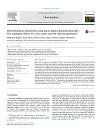This work investigated the capability of using a boron-doped diamond (BDD) electrode for bacterial disinfection in different water matrices containing varying amounts of chloride. The feed water containing Pseudomonas aeruginosa was electrochemically treated while applying different electrode conditions. Depending on the applied current density and the exposure time, inactivation between 4- and 8-log of the targeted microorganisms could be achieved. The disinfection efficiency was driven by the generation of free chlorine as a function of chloride concentration in the water. A synergetic effect of generating both free chlorine and ozone in situ during the disinfection process resulted in an effective bactericidal impact. The formation of the undesired by-products chlorate and perchlorate depended on the water matrix, the applied current density and the desired target disinfection level. In case of synthetic water with a low chloride concentration (20 mg L−1) and an applied current density of 167 mA cm−2, a 6-log inactivation of Pseudomonas aeruginosa could be achieved after 5 min of exposure. The overall energy consumption ranged between 0.3 and 0.6 kW h m−3 depending on the applied current density and water chemistry. Electrochemical water disinfection represents a suitable and efficient process for producing pathogen-free water without the use of any chemicals.
